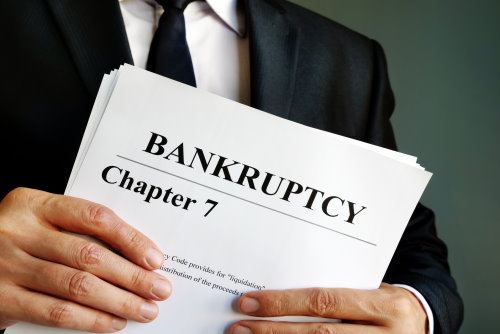When filing for bankruptcy under Chapter 7 or Chapter 13, you need various forms of financial documentation. There are also various official forms that you will need to fill out and file with the Bankruptcy Court. This article provides an overview of the key documents and forms required to file for an individual (or joint) bankruptcy in Texas.
7 Types of Documentation You Need to File for Bankruptcy Under Chapter 7 or 13
Filing for bankruptcy under Chapter 7 or Chapter 13 requires proof of your current financial standing. As a result, to begin the process, you will need documentation including:
Tax Returns
If you plan to file under Chapter 7, you will need copies of your tax returns from the two most recent tax years. If you are planning to file under Chapter 13, you will need years’ worth of returns. If you don’t have copies of your returns, you can request tax transcripts from the Internal Revenue Service (IRS).
Proof of Income
Filing for bankruptcy also requires proof of income. This includes recent pay stubs and W-2s if you are an employee, and it typically includes profit-and-loss statements if you are self-employed. If you receive Social Security benefits, workers’ compensation benefits, or any other government benefits, you will need proof of these sources of income as well. The same goes for rental income, rideshare income, and any other sources of income you may have.
Bank and Retirement Account Statements
You will need to provide copies of your recent bank and retirement account statements to the bankruptcy trustee. For now, it is a good idea to make sure you have a complete list of your accounts and the know-how to log in to download your monthly statements.
Vehicle Value, Registration, Loan, and Insurance Documents
If you own a vehicle, you should collect a copy of your registration, your loan documents, and proof of insurance. You will also need proof of your vehicle’s value. You can get an estimate of your vehicle’s value from the National Automobile Dealers Association (NADA) or Kelley Blue Book (KBB) to start. This will usually be enough, but bankruptcy trustees will request more formal valuations in some cases.
Home Value, Deed, Mortgage Statements, and Insurance Documents
You will also need similar documentation for your home if you are a homeowner. This means that you should locate copies of your deed, recent mortgage statements, and proof of insurance. You may also need to provide proof of your home’s current fair market value, and your bankruptcy attorney can help you with obtaining a satisfactory valuation.
Alimony and/or Child Support Documentation
If you receive or pay alimony and/or child support, you will need documentation of your receipts or payments as well. You may also need a copy of your alimony or child support order. If you are recently divorced, the bankruptcy trustee may also request a copy of your divorce settlement agreement or divorce decree showing the distribution of your marital property.
Credit Counseling Certificate
Under federal law, anyone who intends to file for bankruptcy under Chapter 7 or Chapter 13 must first take a credit counseling class. You must take a class offered by a U.S. Trustee-approved credit counseling agency, and you must obtain a certificate of completion to include with your bankruptcy petition.
These are not necessarily the only forms of documentation you will need, but they are the most common forms of documentation, and some of these can also be the most difficult to track down. Once you begin the bankruptcy process, your attorney will be able to advise you regarding any additional forms of documentation you may need to complete your bankruptcy successfully.
5 Types of Forms Required for a Chapter 7 or 13 Bankruptcy
Once you collect all necessary documentation, then you can begin the process of filing for bankruptcy. Whether you file under Chapter 7 or Chapter 13, the following are five of the main types of forms that you will need to complete and file:
Voluntary Petition (Form 101)
The Voluntary Petition (Form 101) is the main form you use to initiate your bankruptcy filing. The form is nine pages long, and it requires you to provide various pieces of information and answer a long list of questions.
Application to Pay Filing Fee in Installments or Fee Waiver for Chapter 7 (Form 103A or 103B)
If you cannot afford the filing fee, you will need to submit an Application to Pay Filing Fee in Installments (Form 103A) or a Fee Waiver for Chapter 7 (Form 103B). The current fees are outlined on the U.S. Courts website, and your attorney can explain if you qualify to file Form 103A or Form 103B if desired.
Creditor Matrix
A creditor matrix is essentially a list of all of the creditors (the companies to which you owe money) that will be affected by your bankruptcy filing. The U.S. Courts have an online system for completing creditor matrices, and your attorney can help make sure that you prepare your matrix correctly.
Statement of Social Security Number
The Statement of Social Security Number is a one-page form that the Bankruptcy Court will use to identify you (and your spouse, if applicable). You must also list any tax identification numbers (TINs) you currently use or have used in the past.
Summary and Schedules of Assets and Liabilities
When filing for bankruptcy under Chapter 7 or Chapter 13, you must submit a summary of your assets and liabilities. You must complete various Schedules depending on the assets you own and the debts you owe. Your attorney can explain which Schedules you need to use and help you complete them appropriately.
Discuss Your Situation with a Plano Bankruptcy Lawyer for Free
Do you have questions about filing for bankruptcy under Chapter 7 or Chapter 13? If so, we can help, and we encourage you to schedule a free, no-obligation consultation. To speak with an experienced Plano bankruptcy lawyer in confidence, call 972-881-9700 or request an appointment online today.

